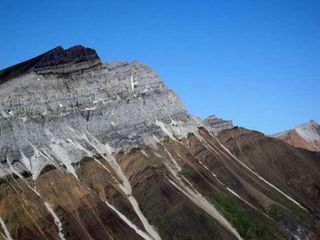Cold Water Tossed on 'Snowball Earth' Theory

Although increasing levels of greenhouse gases in the Earth's atmosphere these days are seen as a harbinger of doom, millions of years ago they may have rescued the planet from a deep freeze.
Some researchers believe that at points in our planet's history — at least two, possibly three times — ice blanketed its surface, down to the equator and across the oceans, forming a "Snowball Earth."
But new research raises questions about whether a surge in carbon dioxide — one of the greenhouse gases responsible for modern, human-caused global warming — could have been responsible for the big thaw that followed the most recent Snowball Earth, about 635 million years ago. And if there wasn't a greenhouse effect big enough to melt the thick veil of ice, perhaps, the researchers suggest, Earth may not have been a big, icy snowball at the time.
An international team of scientists analyzed the molecular composition of rocks laid down in what is believed to be the aftermath of this Snowball Earth.
Snowball Earth could have been self-sustaining, for at least a time, because the white, ice-covered surface of the planet would have reflected sunlight back into space, keeping the planet cool.
The primary evidence for these icy times, particularly the one about 635 million years ago, comes in the form of deposits of rocks ground up and carried by glaciers. These have been found around the world at locations which, about 635 million years ago, would have been located near the equator. These deposits have another layer of rock on top of them, called cap carbonates, which was believed to have formed as the glaciers melted or shortly afterward.
It is believed that Snowball Earths came to an end when the carbon dioxide levels in the atmosphere surged, creating a global greenhouse that melted away much of the ice. This could have begun because volcanoes spewed the gas into the atmosphere.
Sign up for the Live Science daily newsletter now
Get the world’s most fascinating discoveries delivered straight to your inbox.
The normal processes that would pull the carbon dioxide out of the atmosphere were blocked by ice, which prevented carbon dioxide exchange between the atmosphere and ocean. The cold would also have prevented natural rock weathering reactions from pulling carbon dioxide, in the form of carbonic acid, out of the atmosphere and turning into bicarbonate. This would have allowed for an intense buildup of the greenhouse gas.
To find out how much carbon dioxide was around at the time, researchers analyzed the chemical composition of rocks taken from one of these deposits in Brazil, and the organic matter fossilized within them. The researchers also looked at data from samples from elsewhere in the world. They looked at ratios of carbon isotopes, molecules of carbon that have different atomic weights, in both the rocks and the organic matter fossilized within them. [Big Freeze: Earth Could Plunge into Sudden Ice Age]
Both the rocks and the organic matter — mostly algae — form using carbon from carbon dioxide dissolved in the ocean. However, a lower concentration of carbon dioxide causes the algae to take up more of the heavy version of carbon. The ratio of carbon isotopes picked up by the carbonate rocks, however, doesn't change, regardless of the carbon dioxide concentration. So by comparing the ratios from the two sources, the scientists could get an idea of what the concentration of carbon dioxide was in the ocean, and hence the atmosphere, at the time.
They found it was much lower than expected. While previous estimates had put the carbon dioxide concentration at as much as 90,000 parts per million, this new analysis put it lower than 3,200 ppm, possibly as low as it is today, about 400 ppm.
"Since we record a very low carbon dioxide concentration in the atmosphere it seems to be there was never a high concentration of carbon dioxide in the atmosphere, which means it cannot have been a Snowball Earth, otherwise it would still be frozen," said Magali Ader, a study researcher and assistant professor at the Institut de Physique du Globe de Paris,.
There is a lot of uncertainty in the finding, she cautions. It's possible, due to difficulties in dating, the rocks they tested weren't deposited until well after the Snowball Earth had passed, when the high concentration of carbon dioxide had begun to clear, and it's possible another greenhouse gas, methane, may have been responsible.
Perhaps one of the biggest questions surrounding Snowball Earth is how life managed to survive, since there is no evidence of mass extinctions. Tiny, heavily armored marine fossils have shown up in cap carbonate rocks leading scientists to suggest that these creatures thrived in an interval between two glaciations.
You can follow LiveScience writer Wynne Parry on Twitter @Wynne_Parry. Follow LiveScience for the latest in science news and discoveries on Twitter @livescience and on Facebook.
